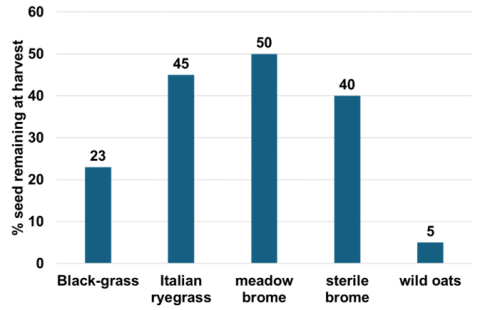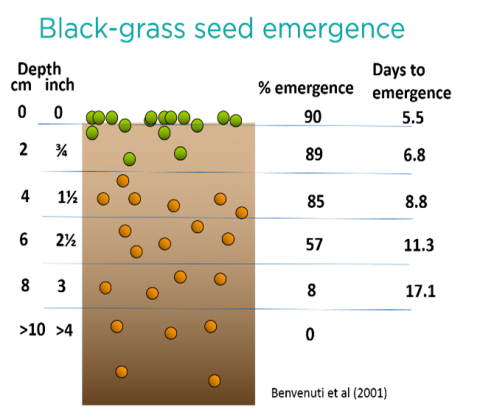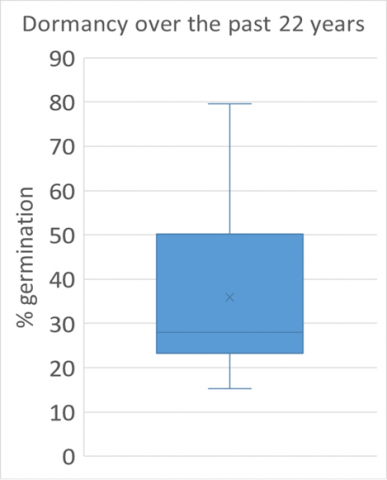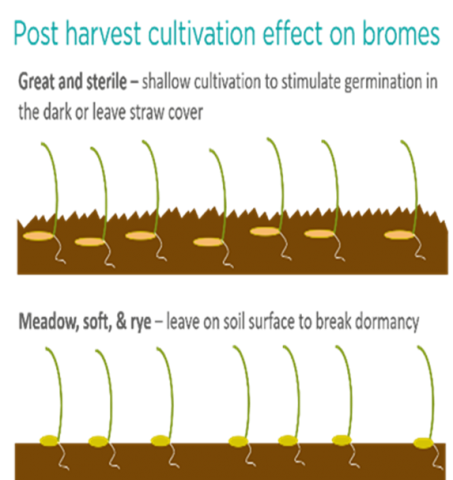Sarah Cook
Desiccation
Desiccation is for evening out crops and killing weeds, it does not dry them but assists in the process. Generally, grass weeds will have already shed their seed but there will be some small tillers still being produced and these will be killed.
There are plenty of weeds because it has been wet and glyphosate will be effective at killing these. It should be applied when cereal grain has less than 30% moisture content. Walk fields to note weed presence and adjust dose rates dependent upon weed species to ensure there are no survivors.
The harvest interval of pre-harvest glyphosate is a minimum of seven days, but often it can take 14 days or more to see and benefit from the full effects of treatment. This harvest interval must be met to avoid any glyphosate residue in grain samples.
Weed seed present at harvest
A recent Harvest Weed Seed Control project has shown that by adding a Seed Control Unit (SCU) to the combine, weed seed return can be significantly reduced. Figure 1 below shows the seed remaining on plants at harvest, there is a considerable amount of variation between plants and between sites. Previous research has shown up to 80% of seed was retained by Italian ryegrass, unlike the 45% recorded here. Preventing seed return is a key part of an IPM strategy for the control of these increasingly herbicide resistant weeds.

Figure 1. Seed remaining on grass weeds at harvest taken from Bofin (https://bofin.org.uk/harvest-weed-seed-control-project-results/) sample number 26.
What to do with stubbles after cereals
Black-grass control
Stale seedbeds are not always successful for encouraging black-grass to germinate. A shallow cultivation immediately after harvest followed by rolling for consolidation and good seed/soil contact could encourage black-grass emergence. Deeper cultivations will delay emergence of black-grass (see figure below). In wet conditions where the soil is moist a stale seedbed should be successful and emergence should be rapid although dormancy will play an important role here.

Is seed dormancy a factor? Over 22 years of testing the average level of dormancy for freshly shed seed is 35% germination. In really hot years we see low dormancy where the weed is ready to germinate, sometimes prior to harvest, in cold years it is more reluctant. This year the weather has been quite cold during the ripening phase so a higher dormancy is expected.

Seed already in the seedbank will germinate if exposed to air and moisture during cultivations.
In dry situations it is better to leave stubble untouched, dews will wet the surface having direct access to freshly shed seed. Seed can naturally be killed by desiccation and predation from mammals, birds and insects.
Brome control
Sterile and great brome need darkness to germinate and covering seed with soil will add to the emergence, although chopped straw will often be enough. If straw is removed then a shallow cultivation with rolling is often necessary.

Rye, soft and meadow brome need to be left on the soil surface for at least a month to complete ripening and breaking of dormancy.
If you have mixed species then target the sterile and great brome as these are more difficult to control with herbicides.
Ryegrass control
Emergence is more protracted than with black-grass. Leaving land uncultivated will expose seed to predation and mortality. Stale seedbeds are beneficial.
Wild oats control
Seed become viable approximately 10 days after fertilisation and shedding occurs over an extended period. Seed dormancy varies with population and position of the seed on the plant. Leaving soil untouched allows predation and mortality to occur with seed losses as high as 85%. Burial can increase levels of dormancy and persistence.
Herbicide resistance
We are still accepting seeds for resistance testing and now is the key time to collect black-grass. More information can be found here https://www.adas.uk/Service/Herbicide-resistance-testing

